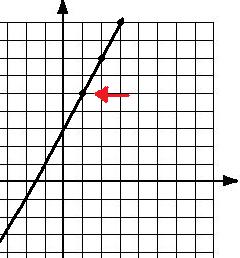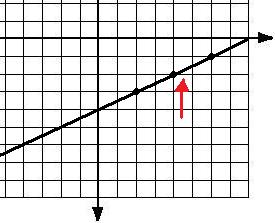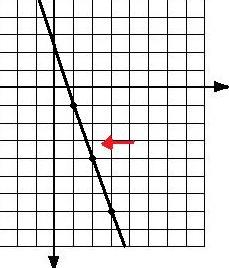



Some Helpful Tools
Math: Slope-Intercept Form - Theory
Getting Started
This section will combine both the Intercepts Theory and the Slope of a Line Theory. The slope-intercept form is:
y = mx + b
This form represents a line. The slope of
the line is m, and the y-intercept is b. This
form is used to graph the solutions of an
equation on a coordinate plane.
Let's look at some examples using the
slope-intercept form.
Example 1: y = 2x + 3
To find the solution to this equation, randomly choose any number for x. Let's suppose you choose the number 3. Plug
3 into the value for x.
y = 2x + 3
y = 2(3) + 3
y = 6 + 3
y = 9
Since you already know the value for x is
3, you now have a coordinate point of
(3, 9).
In order for the graph to have many points, choose another number for x. This time, let's suppose you choose 2.
y = 2x + 3
y = 2(2) + 3
y = 4 + 3
y = 7
This will give you another coordinate point of (2, 7).
Lastly, let's choose 1.
y = 2x + 3
y = 2(1) + 3
y = 2 + 3
y = 5 (1, 5)
Now you're ready to plot the three points on the coordinate plane. Those three
points again are: (3,9), (2,7), and (1,5).
More Slope-Intercept Form Practice
Once you have plotted all of the points, form an equation based on where the points fall on the line and the direction that the line is going.
Because the line is going upward, you know that the last number in the equation will be positive. Since the line crosses the
y-axis at positive 3, you know that the last
number in the equation will be positive 3.
To find the slope, choose two of the three points. This will help you locate the other points on the line. Here's how. Let's choose points (1,5) and (2,7) as
set one and set two.
The first set represents x y . The second
set represents x y . To find the slope, subtract the second set from the first set beginning with the value for y.
The slope is , with the y-value as 2 and the x-value as 1. This means that you can
start with a point on the line and count 2
units up (for the y-axis) and 1 unit across
(for the x-axis) to find another point. Since a line is endless, the points on a line are also endless.
If you can count the vertical and horizontal units of the slope and always land specifically on the line, then your slope is correct.
Hint: When a fraction is in the value for m in the slope-intercept form y=mx+b, that is the slope of the line. When a whole number is in the value for m, imagine that
whole number over the number 1.
Example 1: y = x + 4
Example 2: y = 2x + 3
Example 3: 2y = 3x + 6
Here, the slope can be found by dividing both sides by 2. The slope will be .

=
2
1
Example 2: Graph the solutions of
y = - 3x + 2
Just by looking at this equation, you can
tell that the slope is -3 and the y-intercept
is 2. This means that the line intersects the y-axis at (0,2). You can randomly choose some numbers for x. Let's choose 1, 2, and 3.
y = -3(1) + 2
y = -3 + 2
y = -1 (1, -1)
y = -3(2) + 2
y = -6 + 2
y = -4 (2, -4)
y = -3(3) + 2
y = -9 + 2
y = -7 (3, -7)
Let's choose points (1, -1) and (2, -4) to
find the slope of the line.
-4 - (-1)
slope = 2 - 1 =
The slope is -3 (as shown in Example 2.) You can move down 3 units and across 1 unit to find any point on the line.
Example 3: Graph the solutions of
y = x + (- 4)
Begin by finding three numbers to represent x. Let's try 2, 4, and 6.
y = (2) + (-4) y = (4) + (-4)
y = (6) + (- 4)
To find the slope, choose two of the three points. Let's choose points (2,-3) and
(4, -2) as set one and set two.
-2 -(-3)
slope 4 -2
y = 2x + 3
slope =
-3
1
1
2
1
2
1
2
1
2
y = 1- 4
y = -3
(2, -3)
You may recall that slope is used to describe steepness, and intercept is used to describe a line that intersects or crosses another line.
This section will cover the fundamentals and rules of the slope-intercept form. Plus, check out the video tutorial at the bottom of this page. Let's get started!


y = -3x + 2
y = x - 4
1
2
y = 2 - 4
y = -2
(4, -2)
y = 3 - 4
y = -1
(6, -1)
=
=
1
2
The line crosses the y-axis at (0,-4). The
slope is . You can start with a point on
the line then go up 1 unit and across 2 units to find the next point on the line.
To find the slope-intercept form equation for a line found on the x-axis, count the units from the x-axis in the direction of the graph line.
For example: If the graph line is found 4 units below the x-axis, the equation is
x= -4.
If the line is found on the y-axis, count the units from the y-axis in the direction of the graph line.
For example: If the graph line is found 5 units to the left of the y-axis, the equation is y = -5.
When given the slope and the y-intercept,
you will be able to write an equation for
a line.
1
2
y - axis
x - axis
7 - 5
2 - 1
1
1
2
2
2
1
2
3
2
1
The slope tells you to go up 2 spaces and over 3 to find the next point on the line.
Here the slope is . This means to go up 2 spaces and over 1.
3
2
How to write an equation for a line when given the slope and the y-intercept.
Example: m= -3, b = 5
Begin by using the slope-intercept form.
y = mx + b
y = -3x + 5
The line for this equation will pass through the y-axis at (0,5), It is a negative slope, which means that you will go down 3 units and to the right 1 unit.